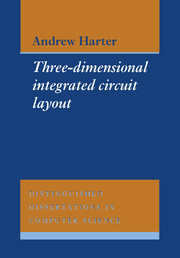Book contents
- Frontmatter
- Abstract
- Preface
- Contents
- List of Figures
- List of Plates
- List of Tables
- List of Algorithms
- Glossary of Terms
- 1 Introduction
- 2 Two-Dimensional Chip Design
- 3 Three-Dimensional Chip Technology
- 4 Three-Dimensional Circuit Topology
- 5 Three-Dimensional Cell Tessellation
- 6 Three-Dimensional Abutment System
- 7 Abutment System Configuration
- 8 Abutment System Evaluation
- 9 Conclusions
- A Layout Editor Configuration
- B Layout System Data Structures
- C Cell Description Rules
- D Circuits
- References
- Index
9 - Conclusions
Published online by Cambridge University Press: 05 May 2010
- Frontmatter
- Abstract
- Preface
- Contents
- List of Figures
- List of Plates
- List of Tables
- List of Algorithms
- Glossary of Terms
- 1 Introduction
- 2 Two-Dimensional Chip Design
- 3 Three-Dimensional Chip Technology
- 4 Three-Dimensional Circuit Topology
- 5 Three-Dimensional Cell Tessellation
- 6 Three-Dimensional Abutment System
- 7 Abutment System Configuration
- 8 Abutment System Evaluation
- 9 Conclusions
- A Layout Editor Configuration
- B Layout System Data Structures
- C Cell Description Rules
- D Circuits
- References
- Index
Summary
Review
Aims
This dissertation has presented an investigation into three-dimensional integrated circuit layout and cell design. The primary goal of the investigation was to discover the potential benefits of such layout, and to determine whether those benefits justify the considerably more complex and costly techniques of fabrication which are involved.
Similar questions for other difficult fabrication techniques are more readily answered. The cost of techniques used to make smaller transistors is constantly being justified by the denser, faster and more highly integrated circuits and systems which result. It is also the case that such technology does not introduce any fundamentally new layout problems. A more difficult question to answer concerns the value of wafer-scale integration. This is because the benefits are clouded by yield problems, and new layout and fabrication methodologies must be introduced to achieve fault or failure tolerance. The best methods are still to be determined.
The value of three-dimensional integration is a yet more difficult question. The technological difficulties are as apparent as they are abundant, and include yield degradation and thermal stresses during fabrication and heat dissipation and crosstalk during circuit operation. However, the nature of the benefit is not clear. It has been speculated that three-dimensional circuits might be denser and faster, having shorter wiring and offering greater connection capabilities. These benefits are expected because of the inherently richer connection topology which the three-dimensional arrangement of devices offers. Little has been done and less has been published about such speculation.
Preliminary research
As with any new topic of such complexity, an investigation into three-dimensional integrated circuit layout is open-ended.
- Type
- Chapter
- Information
- Three-Dimensional Integrated Circuit Layout , pp. 169 - 176Publisher: Cambridge University PressPrint publication year: 1991



